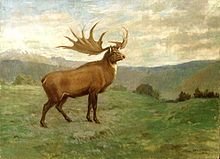Manx Museum’s Iconic Ancient Giant Deer Returns To Its Rightful Place
Standing proudly in the Manx Musuem (Manx: Thie Tashtee Vannin) for over a century the skeleton of The Irish Elk has had pride of place. Over recent months Manx National Heritage (Manx: Eiraght Ashoonagh Vannin) the organisation responsible for protecting and promoting the Isle of Man’s heritage and culture, has undertaken detailed study, cleaning and conservation work on the Giant Deer. Much of this significant work has been tackled by Manx National Heritage’s conservator Chris Weeks.
The Giant Deer, commonly known as an Irish Elk because of the many finds in Ireland, was excavated in 1897 at Close y Garey near the village of St John's (Manx: Balley Keeill Eoin) which lies in the central valley of the Isle of Man (Mannin). The 1897 excavation team was led by Manx antiquarian and historian P.M.C Kermode, who later became the Manx Museum’s first curator. The almost complete skeleton had the back of the skull and tail missing at the time of excavation which have been replaced by modelled plaster. The two large neck bones which were also missing were filled by bones from a find in Ireland.
The Irish Elk (Megaloceros giganteus) or more accurately the Irish Giant Deer, is an extinct species of deer and is one of the largest deer that ever lived. This magnificent animal evolved through the Pleistocene epoch and lived into the early Helocene epoch. The Pleistocene epoch is the geological epoch which lasted from about 2,588,000 to 11,700 years ago, spanning a period of repeated glaciations. The Holocene epoch is the geological epoch that began after the Pleistocene at approximately 11,700 years and before 2000 AD. The Irish Giant Deer found on the Isle of Man has a skeleton that is 5.58ft (1.7 metres) tall at the shoulder, with an antler span of over 8ft 6ins (2.6 metres). The deer roamed the open tundra landscape towards the end of the last Ice Age.
The depiction below is by American natural history painter Charles Robert Knight (October 21, 1874 – April 15, 1953)

- Alastair Kneale's blog
- Log in to post comments






